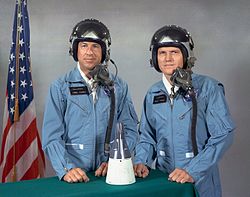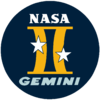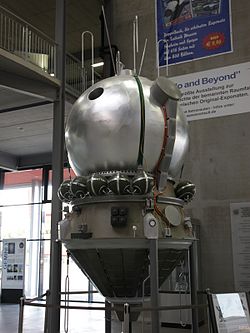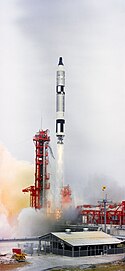Gemini 7
- För andra betydelser, se Gemini.
| Gemini 7 | |||
 | |||
| Statistik för uppdraget | |||
|---|---|---|---|
| Uppdrag | Gemini 7 | ||
| NSSDC-ID | 1965-100A[1] | ||
| Modell | Gemini | ||
| Anrop | Gemini 7 | ||
| Varaktighet | 13 d 18 h 35 min 1 s | ||
| Uppskjutning | |||
| Raket | Titan II | ||
| Uppskjutningsramp | Cape Kennedy Air Force Station LC 19, Florida | ||
| Uppskjutning | 4 december 1965 19:30:03 UTC | ||
| Landning | |||
| Landning | 18 december 1965 14:05:04 UTC | ||
| Landningsplats | Atlanten 25°25′N 70°6′V / 25.417°N 70.100°V | ||
| Omloppsbana | |||
| Distans | 9 029 771 km | ||
| Apogeum | 302 km | ||
| Perigeum | 299 km | ||
| Grader | 28,9° | ||
| Besättning | |||
| Besättning | Frank Borman (1) Jim Lovell (1) | ||
 V-H: Lovell och Borman | |||
| Kronologi | |||
| |||




Gemini 7 (officiellt Gemini VII) var NASA:s fjärde bemannade färd i Geminiprogrammet och 10:e bemannade färden totalt. Astronauterna Frank Borman och Jim Lovell flög ombord. Färden genomfördes 4-18 december 1965 och varade i 330 timmar 35 minuter och 1 sekunder. Farkosten sköts upp med en Titan II-raket från Cape Kennedy Air Force Station.
Man flög i formation med Gemini 6 och var som närmast endast 0,3 meter från varandra.
Källor
Fotnoter
- ^ ”NASA Space Science Data Coordinated Archive” (på engelska). NASA. https://nssdc.gsfc.nasa.gov/nmc/spacecraft/display.action?id=1965-100A. Läst 27 mars 2020.
| |||||||||||||||||||||
| |||||||||||||||||||||||||||||||||
Media som används på denna webbplats
Författare/Upphovsman: Pascal (Flickr user: pasukaru76), Licens: CC0
Vostok spacecraft replica at the Technik Museum Speyer, Germany.
Gemini 7 as seen from Gemini 6 during their rendezvous in space
A bank of clouds over the western Pacific Ocean was photographed by Astronaut Frank Borman and James A. Lovell during the Gemini 7 mission. In the background the moon can be seen.
S65-61650 (4 Dec. 1965) --- The Gemini-7 spacecraft, carrying astronauts Frank Borman, command pilot, and James A. Lovell Jr., pilot, was successfully launched by the National Aeronautics and Space Administration from Pad 19 at 2:30 p.m., (EST) Dec. 4, 1965. The Gemini-7 spacecraft is scheduled for a 14-day mission in space.
Color scan of an original Gemini 6A patch, revised from the Gemini 6 patch, which had "GTA-6" at the top rather than "GEMINI 6."
Design for the emblem of the Gemini VII spaceflight. At left of hand-held torch is a Gemini spacecraft. Roman numeral indicates the seventh flight in the Gemini series. Prime crew men for the mission are astronauts Frank Borman, command pilot, and James A. Lovell Jr., pilot. The NASA insignia design for Gemini flights is reserved for use by the astronauts and for other official use as the NASA Administrator may authorize. Public availability has been approved only in the form of illustrations by the various news media. When and if there is any change in this policy, which we do not anticipate, it will be publicly announced.
Gemini 5 Patch
Gemini 7 spacecraft on display at the Steven F. Udvar-Hazy Center in Chantilly, Virginia.












